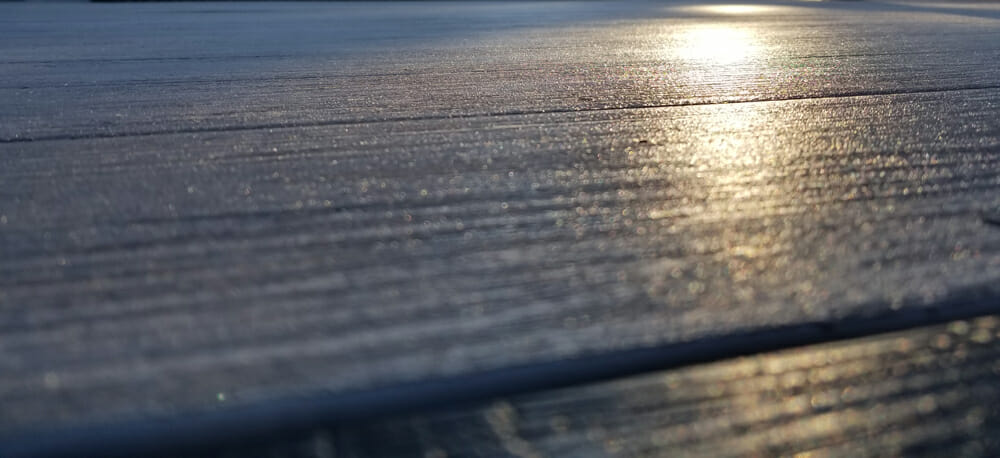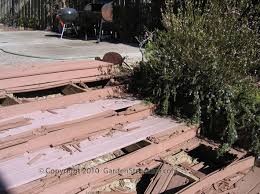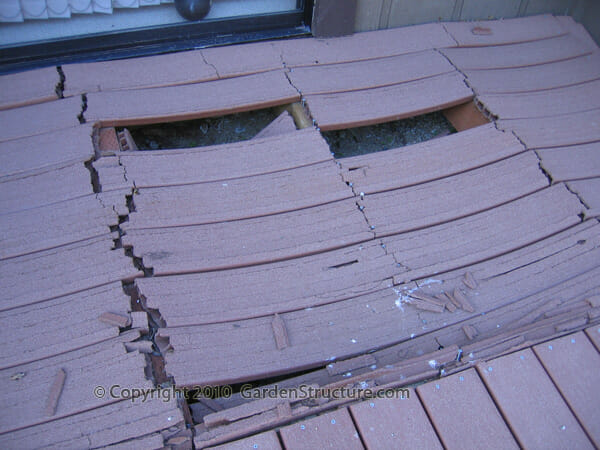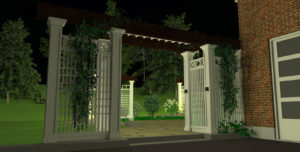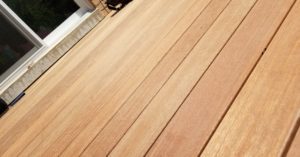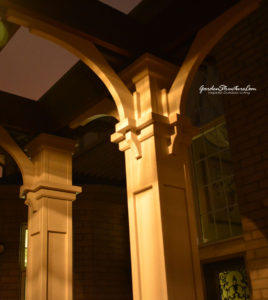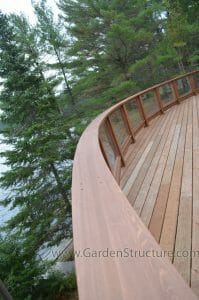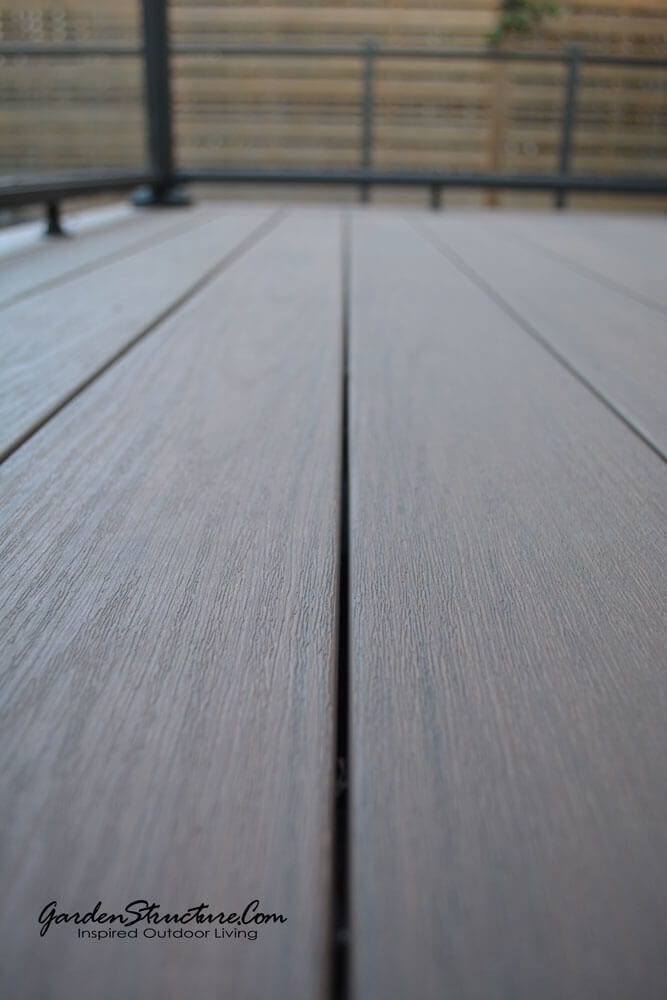
Composite Decking vs Wood
Composite Decking VS Wood Decks
By Lawrence Winterburn
Updated 1/7/2018
When it comes to Composite decking VS Wood Decks, great things are happening. Composite decking products are getting better, weaker products are being culled. New Things Are Happening in the Composite Industry. Composite decking, at least the first generation composite products that people were complaining to me about for the past 15 or so years is dead. Nobody buys the old porous, mold creating composites anymore. Why??? Advancements have been made to make man-made decking last far longer, look much better, (Much more like wood), and some are even offering a warranty that matches their claims. In the photo above, try to guess which ones are wood, and which are composite. Read on until the end of this update to find out.
Composite Decking Companies that Went Out of Business in 2017:
The following decking companies went out of business last year.
- Nylodeck
- Endeck
- Clubhouse
- Kleer
- Gossen
Sadly, a couple of them were not the weakest products, but the consolidation continues. Four of the five companies produced PVC decking. If you purchased any of these products you likely have no warranty on your composite deck. This has to be taken into consideration when purchasing a composite deck.
4 types of Composite Decking with very different expectations:
First Generation Composite Decking
Recycled plastic and wood fiber heated and processed to create wood. Recently a friend of mine heard about the first Trex Deck in Canada being removed. He managed to get a piece of it, and the boards hadn’t failed. They were discolored, it had swelled a bit, but it didn’t fail. People expected it to stay beautiful for decades due to the aggressive marketing and slick advertising, however, it just didn’t meet expectations. These products make up a very small part of the market–less than 10%, and it is usually some kind of blowout sale that supplies the materials.
Clad Composite Decking in 2018
All the big companies, Trex, Azek, Timber Tech, Fiberon, and Wolf, (I am sure I missed a few) now produce decking with a hard plastic shell bonded to the composite board. This makes the wear surface less prone to staining from barbecue messes, food, and wine spills and does away with the tanning butter risk. The hard durable shell prevents mold growth visibility. It may still happen–but not it’s not visible. These products are also producible at a price point similar to the old products. Some companies use Rice husk fiber to eliminate the risk of mold altogether. These new capped composite products are still heavy, prone to a bit of noticeable sag between joists long term, but all in all, they age much more gracefully than the first-generation material.
Clad PVC in 2018
Azek and Wolf are the primary manufacturers of Clad PVC Decking. Each is much better than the old-school composite. No worry of mold, they are colorfast, (minimal fading to be expected), they look like wood, are lighter weight, and don’t tend to sag between joists long term. I like both. I like one more than the other because of their warranty…
Rigid PVC that accepts a finish
TruGrain Decking has come out with a product that you can stain just about any color you like, and it gives a wood-like grain that looks much like Ipe or Mahogany. It is strong, doesn’t shrink much and the finish they sell has done very well in all the tests against first-gen composites. When they were all faded out, TruGrain still had much of its color. I do like PVC products because they are a known commodity. We know they are rigid and near structural material, and with a UV coating, UV degradation isn’t likely.
This is capped PVC by Wolf Home Products atop Ipe interior floor. The new capped decking looks convincingly like wood.
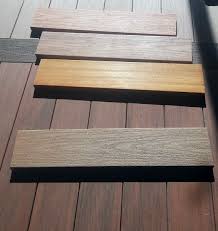
Labor Warranties are Finally Here
Labor Warranties are now becoming the norm among the leaders in the composite decking business.
Wolf, Fiberon, and Trex now include the labor to replace defective decking within their Warranty– HOWEVER, A builder has to buy a certain amount of product in order to qualify for compensation and undergo training by the companies. Wolf is the standout, they only require the builder to undergo product training to qualify and I believe that is online. This means that should Wolf produce a bad batch of material, as long as the builder you choose is approved by them, you the customer will not have to pay a builder to replace the materials for a certain amount of time. As usual, you need to read the warranty. For instance, if the deck builders you choose do not buy $200,000 worth of material from Trex in a year, they won’t honor the warranty.
Read the Warranty!
Reading the warranty documentation from start to finish is crucial to choosing material. The warranty will often point out inherent flaws in the product–basically, everything they exclude tells you a lot about the issues with any product.
Most better products have stain and fade warranties, the best products cover labor for 5 years.

Wolf PVC decking going on a PT frame with hidden fasteners. Joists get flashed to help the PT last as long as they expect the ASA-wrapped PVC to last.
30 years vs Centuries
Composite decking has been made for about 30 years now. We humans have been making things outdoors from wood forever. We know generally the best softwoods last 20-30 years, tropical hardwoods last 30-40 in most climates. The majority of the first-generation composite decks are looking a little dated now. They just didn’t live up to expectations. These products, however, have come a long long way in a short time. The plastics that are used on the outside of the high-end decking are the same composition used by automotive companies and that takes decades to fade out. For this reason, I humbly suggest that for appearance and durability and initial price for a prefinished softwood deck, or an unfinished hardwood deck they are just about par with the cost.
The part of the equation that is nudging most people towards capped composite products is maintenance costs long term.
Expansion and Contraction of Composites and PVC Decking
When it comes to composites and PVC decking, depending on the temperature at which it is installed, gaps need to be sized for best results throughout the year. The idea is for gaps to open up in the winter, and expand to tight in the summer without large gaps pushing open, fasteners breaking from pressure, or bulges where the decking is expanding larger than the frame allows.
Do you go with what we know will last 40 years, but will cost you more long-term, or, what costs less and might last just as long?
The answer has recently become less clear– and that’s a good thing.
This page gets so much traffic that I had to get a quick update done for spring. Happy building everyone!
By the way, the photo at the top of the article. All capped PVC decking, with exception of the third board from that top. It’s Kayu Bhatu (Indonesian Stone Wood).
The previous version of the article was Updated on 01-06-2014
Composite decking is Maintenance Free Inaccurate
All Composite decking is better than wood Inaccurate
Composite decking lasts forever Inaccurate
The Composite Decking Debunk
Preface
Many millions of dollars are spent to glamorize composite decking products. Many people are absolutely sure that all composite decking is wonderful. As a tradesman and designer, I get a chance to see these products after a few years of service, with all their flaws exposed. It puts me in a position to question the promises and dissect the language in their marketing materials.
I’ve fielded hundreds of phone calls and emails over the years from people that bought the promises of the composite companies. Many were disappointed when the warranty turned out to be void because the company just wasn’t there, wasn’t honoring the warranty, or their issue was excluded from their warranty. The sad part is that most of the people didn’t research the product until long after they bought it and they started having problems. It’s human nature I suppose; we trust too much. I find myself in the middle of two groups of people equally as passionate and incensed with a product.
I have heard noises recently about virgin PVC products being the focus of a class-action suit. PVC materials may have a tendency to be stained by cooking oils, and tanning butter. If you apply tanning lotion and then lay on the deck, you may have a permanent “Shroud of Turin effect.” I have noticed that the products go a bit chalky and fade out over time, so there just might be merit to the claim. Maybe we can talk about that lawsuit later in the year.
Trex Class Action 2013
The Trex Composite Decking Settlement
Trex has a conditional settlement in place for its latest class action suit. The summary of it is, they will pay you 20% of what you paid for the product or what the contractor paid for the decking upfront, and about 50 cents a foot towards the labor to install it. We charge about $15.00 per square foot to change decking on a typical deck, so 50 cents a foot is a paltry amount. You won’t get your decking changed that cheap. If you can live with looking at the deck, take the money.

If you used a cleaner to try to get rid of the mold, and you kept the receipts, they will pay you $18.00 a jug.
Roll the dice once more and use their “New and Improved decking”, they will give you a 50% discount on decking and fasteners. If you choose to remove the old decking, unfortunately, you will have to pay for the removal, transportation, and disposal of the old decking. That factor wasn’t addressed in the agreement. (In Hindsight, the Capped Composite products made by Trex fared pretty well– you would have been fairly well off to take the discount 2017 edit)
Trex Capped Composite Decking
Trex’s new capped composite decking has had far fewer issues so far. It is by far the hardest cap in the business. Maybe Trex has cured the problems with their decking by switching production to their new cased product–and maybe the Ford Pinto, and Chevy Vega will be discovered to be masterpieces of human engineering. (I always loved the Vega–and the Pinto makes a great drag car 2017 edit). There will likely be fading issues, and the casing might be expanding and contracting at a different rate than the core, so we will wait for the jury on these new products and hope for the best.
It’s not easy being a forerunner in the development of man-made products that are competing with something brilliant created by evolution. Red Cedar, Redwood, Cypress, and Mahogany have been growing and adapting to a rainforest environment for millennia. When you take them out of their rainy environment and use them in a dry environment they last for decades. Their intrinsic beauty and earthy look are something we find attractive as humans. This is why the composite decking companies try to make their products look like wood–which may well be, part of the problem.
Do you have a Composite Decking Failure?
If you have experienced a Composite Decking Failure or any issues like mold or deterioration please tell us about it. Please send us an email with your name and contacts and tell us about your story at plans@gardenstructure.com
Maintenance-free or Low Maintenance?
Composite decking manufacturers stopped claiming “Maintenance Free” when describing their products due to court settlements early on. Currently, they refer to their decking as “Low Maintenance”.
They will tell you that their products will require cleaning a couple of times a year to make it look good again. The cleaners leave the decking looking powdery. They are acidic and chemically strip the finish and kill the mold for a time. Green clients should be aware that to “maintain” these products involves splashing chemicals around your yard. A good stiff brush is required to physically scrub the decking, so it isn’t like mopping a floor in your house.
Composite is Better than Wood for Decks
If it is better than wood—why are they trying to emulate the look of wood. The new products are quite convincing. Big hunks of plastic with wood grain and variable coloring to emulate the look of wood. Sure, it will likely fade, but when it is installed it looks just like wood.
Only wood is wood. Ipe or Mahogany will likely have a durability of 40 years if oiled yearly. A wood deck can be refinished every few years to look new again.
Refinishing a composite deck is now possible, but with varying results—Normally if it gets too tough-looking you replace the decking. 5 years from now, your composite deck will look like a 5-year-old composite deck—with scratches and stains. When you attempt to change a board or two–it is more than likely that the new boards will be an entirely different color than the faded boards you have presently.
Composite Decking News
Composite Decking Lawsuits affecting the Business
Due to composite decking lawsuits, many local lumber yards have cut back on their composite offerings. Many deck builders are apprehensive to install composites due to the now omnipresent rumors of failures and unhappy clients. It is becoming apparent that after a few years composites simply don’t look like they did when they were installed. Color fading and the necessity to clean with the harsh chemicals that leave decks chalky and porous are just a couple of the reasons. Many of the pre-finished wood decks and pergolas found in our gallery were 5 years old when they were photographed and look much like the day they were installed.
Timbertech has had some serious color fading issues and one local deck builder had 2 failures within 1 year, (large decks). As a solution, they tried a new product designed to bond to composite decking. I will be having a look at the coating this summer to see how it is lasting and if it is successful, we will tell you all about this coating system for composite decking.
Numerous class-action lawsuits have been initiated against Trex that are now apparently settled. They also had a voluntary broad-scale warranty issue stemming from flawed composite decking from a now-moth-balled plant. You really have to temper their marketing and warranty promises due to their history. Trex has since come out with a version of their decking which is wrapped with a coating to address the mold issue, though, being new, time will tell if it is a viable solution.
Since this article was written we have literally had hundreds of phone calls and emails expressing horror stories as a result of people buying composite decks through builders. We get many calls from clients that are looking for replacement decking and parts for products no longer produced.
Labor to Replace Excluded from Warranties
The issue of Labor to Replace defective products being excluded from warranties is not being addressed by the composite companies. All but one manufacturer warranty that I have seen excludes the cost of disposal and labor to replace the decking from their warranty. This is the composite industry telling builders that they do not value their time. This is akin to pitting our clients against builders across the country. If you are a builder recommending composite to a client for their deck, you are putting yourself in a potentially dangerous financial position of being liable for damages, ie. you may be bound to supply your labor for free to replace faulty composite decking. Let’s face it–if you make composite decking that is faulty, you cannot ignore the fact that to make the client that purchased the composite decking whole, you need to cover labor and disposal of the defective decking. These companies are relying on slick marketing rather than reputation.
Evergrain (Tamco), actually offers a 5-year warranty that includes replacement costs–Not Disposal of Faulty Decking Products though, which I find strange. Why not go all the way? Though with anything, you need to do research before buying. I didn’t find many complaints about Evergrain when I searched, but you should do your own research before buying any composite product. When you buy a man-made product like composite decking, you need to weigh all the factors. Most builders like the product, but how many of them have that decking that they recommend on their own home and are still happy with it a decade later. Unfortunately, most deck builders never return later to see how the decks they build look 5-10 years later. I see this warranty change as a serious positive.
Composite Companies Closed in the past few years. (A list in progress)
When decking manufacturers or composite companies close, the implied warranty is worthless.
Maybe we need to assess their stock before buying to get an idea of whether they will be there to honor a warranty.
- Correct Deck Filed Chapter 11 Bankruptcy and sold all of its assets to a subsidiary of Building Materials Corporation of America (BMCA) in 2009. (composite decking warranty–Contact CorrectDeck Directly)
- CPI Plastics (EON), Went through a restructuring and could not meet its financial commitments, was liquidated by the creditors in 2009 (composite decking limited lifetime warranty–Worthless)
- Xtendex Manufacturing plant in Barrie (Carney Timber Products) closed and was liquidated. 2007
- Dexx Composite decking plant in Bolton Ontario burned to the ground in 2005. For some reason, they never resumed production.
- ProCell Purchased by AZEK 2008
- GeoDeck Original company no longer operating, Name has been sold to 2 companies since and warranty is no longer valid.
- Brite Bankrupt in 2007, the business closed in 2008 (no warranty service)
- Elk Cross Timbers Purchased in 2007, Closed in 2011
- Monarch Deck Products (Green Tree Composites) Closed in 2008
- Life Time Lumber Business Closed 2011
There are hundreds of now-defunct composite decking companies, this is a list of the largest that we know of companies. Please let us know if there are others you feel should be added to this list.
Coupling Vinyl with Wood
First-generation composites were recycled plastic/vinyl mixed with wood. Unfortunately, the “Pulp” wood they use is made from high sugar species of wood, which are not known for outdoor durability such as pine, spruce, and bark from these trees. This is left over wood that isn’t good enough to use to make paper from.
Since this wood absorbs moisture, then dispels it this creates a pocket within the vinyl that soaks up moisture every time it gets wet. Over time this produces black mold—like in an un-vented shower stall and it will never subside. Cleaners may make it look alright for a few days—but it will always come back and normally worsens with each treatment.
If composite decking contains wood or pulp, it may be prudent to steer clear of the product.
Warranties offered by composite decking manufacturers are notorious for pointing out their tragic flaws. Pool chemicals, mechanical wear, mold growth are often not covered by their limited lifetime warranty.
Composite Decking Testing Methods
Generally, when they test composite decking durability and color-fastness they test for the equivalent of about 6 months in the real world. Furthermore, manufacturers have told me that each batch of composite decking will be a slightly different color. I haven’t personally seen composite testing that included testing for freeze-thaw stability. The first-generation composite was prone to fading from sun exposure
Fade Resistant Composite Decking
Many manufacturers are marketing their decking as fade-resistant. Since the testing is a vague thing, once it gets into the real world it is likely to be a different case. All composite decking fades over time. Here are photographs of Trex Brasilia sent in by Robert Rackish in 2010. “Little did we know that it would fade and pick up stains easily”, he said in an email. He went on to say he has been searching for a product that would restore the color and hasn’t found anything yet.
Robert wetted the decking to show what the original color looked like. In the first photo, you can see the two scraps that are the original color on the faded background.
Is Composite Decking a Structural Material?
When you can legally use composite for joists and handrails then it will be deemed structural materials. Most composite handrails are not Building Code Legal. Most composite manufacturers advise creating a frame that has the joists about 12” apart, rather than the typical 16” since the materials will tend to sag under their own weight.
We get numerous people asking for composite pergolas. Since we can’t fasten to it, or span more than a couple of feet without deflection, designing a pergola is a challenge we just don’t see as worthwhile.
Vinyl Decking (without wood pulp—Virgin Vinyl Composite Decking)
Virgin vinyl decking seems durable and long-lasting. One of our builders says he decides which composite is good by laying it on something solid, hanging a 3” corner off the edge, and giving it a good whack with a hammer. If it shatters off—Don’t use it. He sticks to Virgin Vinyl products and has had good luck. (EON by CPI is not Virgin Vinyl, we would suggest it is a PVC product classed with plastic patio furniture)
Virgin Vinyl decking does expand and contract a great deal and this needs to be accommodated by using different methods for fastening and leaving tolerances (spaces) to allow expansion based on temperature. A variance of about 150 degrees F should be standard in North America, which means up to 2 or 3“ of expansion should be expected with some products for a 20′ piece of decking. Most builders cut the material into shorter pieces so that this expansion is easier to hide.
PVC and Composite Vinyl Fences
Many builders claim that vinyl fencing has improved over the years. Here are some photos of vinyl composite fencing failures. UV breaks down PVC. Spray paint will be nearly impossible to remove.
Composite Warranty Concerns
Builders Selling Composites may have to supply free labor to replace decking?
Speaking as a builder, we have a tough enough time getting jobs finished on a schedule and on budget. We work long hard days to keep our clients happy, and when a warranty issue with a composite decking company causes this relationship to be jeopardized, we need to make tough decisions. Only Evergrain offers a 5-year Limited Warranty that covers Installation Costs–but not disposal costs.
Be Careful out there!
Lawrence
Note: the opinions expressed in these articles are simply the opinion of the author. No malice is intended. If you have information or evidence of errors or possible corrections we invite your comments at gardenstructure@gmail.com

